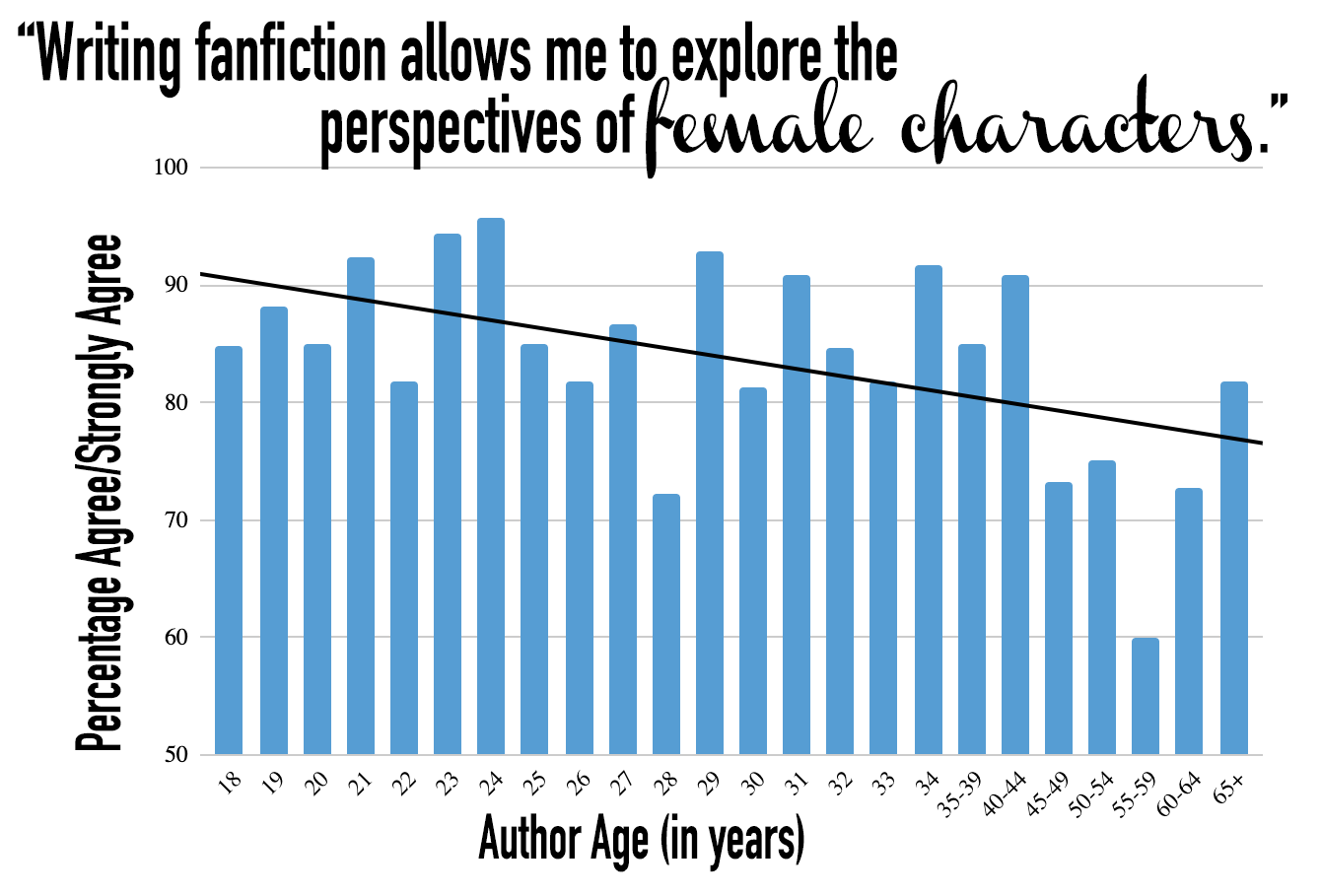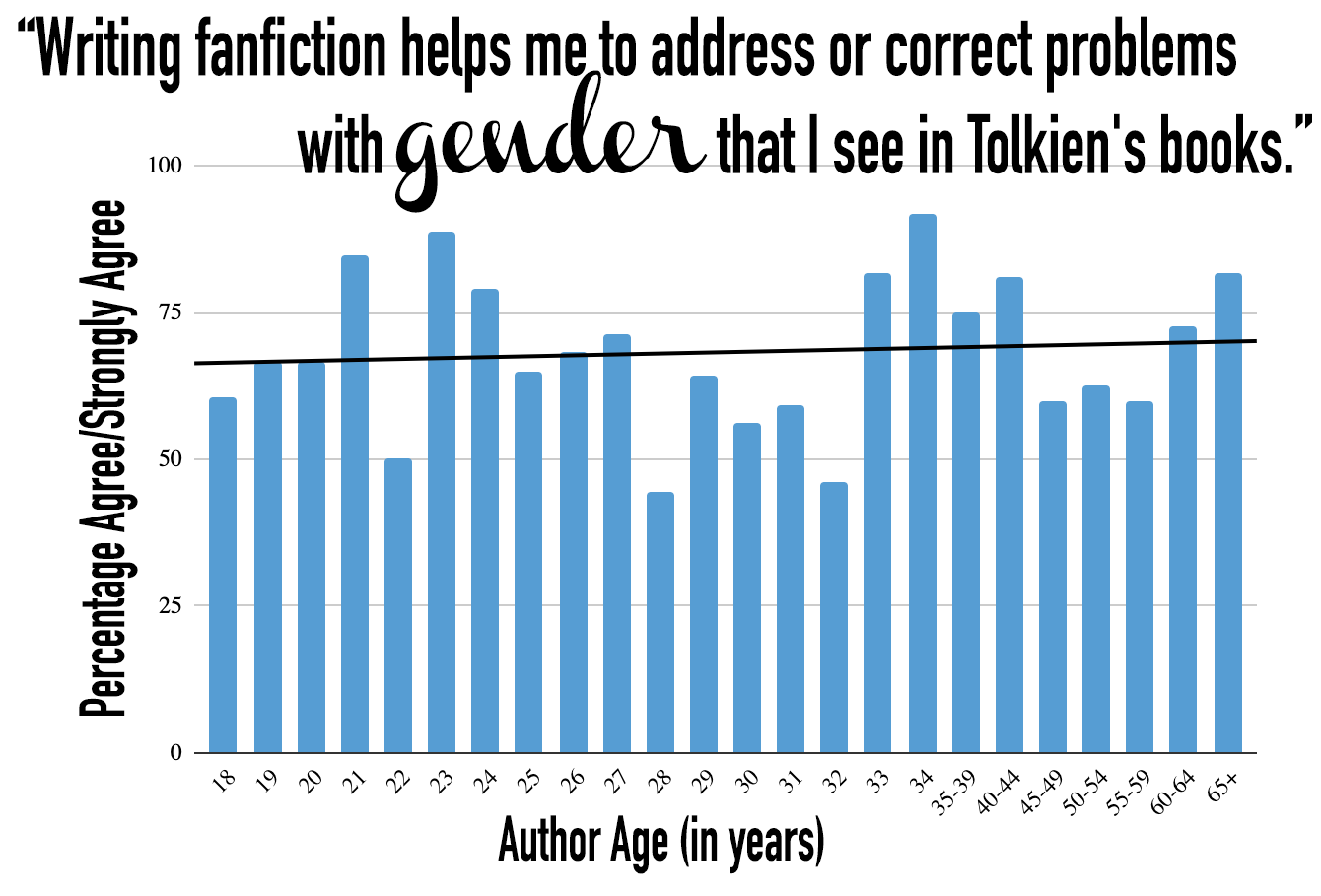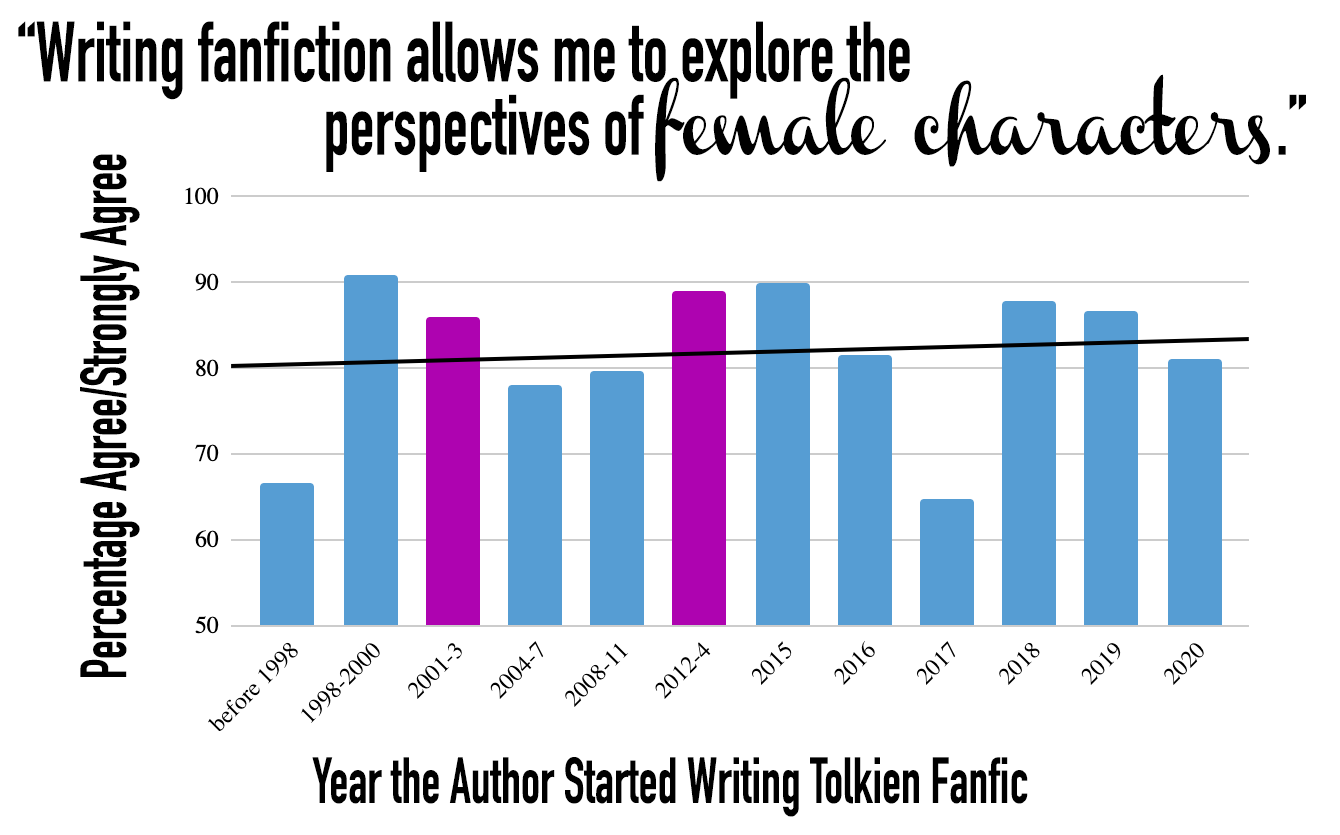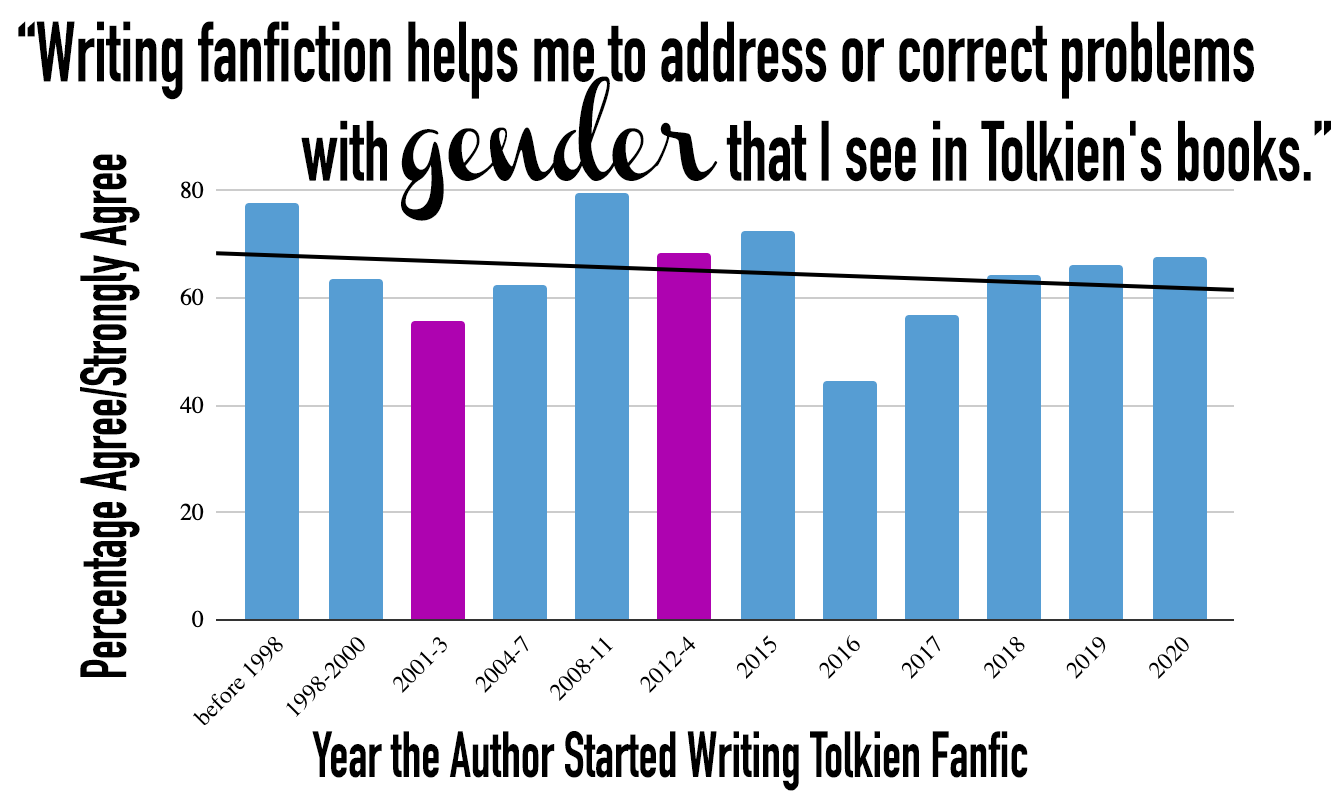Writing Women in Tolkien Fanfiction: An Analysis of the Data by Dawn Walls-Thumma
Posted on 29 October 2022; updated on 29 October 2022
This article is part of the newsletter column Cultus Dispatches.
Tolkien fans like to hold up Tolkien's women characters as examples of how the legendarium includes women in a way that other fantasy series do not. Lúthien, Éowyn, Haleth, and Rose Cotton all present strong women in various roles and facing a range of conflicts. This would, one would assume, pave the way for fanfiction writers to likewise tackle the perspectives of women in their work.
But the inclusion and representation of women in Tolkien fanfiction has, historically, been complicated. In the early fandom, female characters were often saddled with the label "Mary Sue"—a term originating in Star Trek fandom for an original female character whose larger-than-life presence distorts the plot or canon characters—whether they deserved it or not. Characters perceived as self-inserts were particularly open to criticism. The outsized negative reaction these characters received from readers led many authors to avoid writing women altogether.1
Over time, this changed, largely due to the work of fans who wanted to see more writing about women and led events that encouraged the creation of women-centric fanworks. While future columns will look closer at these fans' efforts and the events they created, this month, I look at data from the Tolkien Fanfiction Survey and what it shows of fan fiction authors' attitudes toward writing about women and how time, demographics, and platform use has caused these attitudes to change.
The Tolkien Fanfiction Survey was first run in 2015 and again in 2020 with the assistance of Maria K. Alberto. Consisting mostly of Likert-style statements with the choices of Strongly Agree, Agree, Disagree, Strongly Disagree, and No Opinion/Not Sure, the survey asked about a variety of behaviors, practices, values, and beliefs concerning the Tolkien-based fanfiction that participants wrote and read. Both surveys were Institutional Review Board-approved and had 1,052 participants in 2015 and 746 in 2020. While both readers and writers of Tolkien fanfiction were eligible, this article looks just at authors—readers will be featured at a later date.
With survey data, it is important to always keep in mind that it can only provide a glimpse of a small portion of the fandom. Tens of thousands of people have written and read Tolkien fanfiction over the decades, and only a small fraction of their perspectives are represented here. Furthermore, many fans and communities are unreachable (due to site closures, for example, or language barriers) or difficult to reach, where other fans and communities are comparatively accessible. This skews the perspectives represented toward those most common among the easier-to-reach fans and communities. Therefore, survey data should never be taken as an absolute statement about the fandom but interpreted within this context and these limitations.
Representational Writing
The survey included two items that looked at authors' beliefs and habits around writing women characters. The first item, "Writing fanfiction allows me to explore the perspectives of female characters," aims to identify what I term representational motives or writing. In representational writing, authors aim to increase the number of women in the legendarium and turn the focus to women's perspectives—in other words, represent women in a text from which they are largely absent.
The question of whether or not Tolkien and his works are sexist remains highly contentious. We don't even need to wade into those perilous waters, however, to state the obvious: The legendarium is severely lacking in women. Emil Johansson's LotR Project finds that only 18% of named characters in The Hobbit, The Lord of the Rings (LotR), and Tolkien's posthumous works are women. Were these numbers to reflect the reality in Middle-earth, surely the dearth of women would not go unremarked upon in the text and would probably have severe impacts on population.
The item about representational writing appeared in both the 2015 and 2020 surveys. In 2015, 78.3% chose either Agree or Strongly Agree (which I will, moving forward, denote as simply "agreed" with the item). In 2020, this number increased slightly to 84.3% of participants agreeing.
Here, we see the history of the Tolkien fanfiction fandom playing out. The smaller number of authors interested in writing about women in 2015 may represent the vestiges of a fandom culture that widely discouraged stories about women in both overt and subtle ways. By the 2020 survey, these attitudes are further in the past. Furthermore, the Hobbit films brought an onrush of new fans who didn't carry the baggage of the older fandom, and platform shifts to multi-purpose and multi-fandom platforms meant that Tolkien fandom existed in less of a silo and was exposed to conventions and conversations around representation that were happening more readily in other fandoms than in the Tolkien fandom.
Reparative Writing
A second item, appearing only in the 2020 survey, surveyed authors' beliefs and habits around what I term reparative motives or writing: "Writing fanfiction helps me to address or correct problems with gender that I see in Tolkien's books." Based on Una McCormack's concept of reparative reading,2 this type of writing seeks not just to increase the number of women or view the story from their perspective but to use one's fanfiction as a mode of repair of sexism and misogyny in the texts.
This motive requires authors to not only see women's perspectives as worth writing (representational motives) but to acknowledge that there is sexism in the legendarium and assume the authority to address it. Not surprisingly, the number of authors who agreed with the statement is much lower than the number that agreed with the representational statement: 63.1%.
Demographics I: Gender and Marginalization
Fanfiction has been recognized as a women's genre for the entirety of its existence. The idea that 90% of fanfiction writers are women has been around for decades and confirmed across several studies, including the 2015 Tolkien Fanfiction Survey.3 In 2020, the numbers changed: 73% of participants self-described as women, 15% as nonbinary and genderqueer identities, and 7% as men.
Does a participant's gender influence whether they write about women in their fanfiction? The short answer is: sometimes but perhaps not as much as one might think. (At least, not as much as I assumed it would!)
The graphs below show mini-pie charts for responses to the representational writing item, "Writing fanfiction allows me to explore the perspectives of female characters." The graphs are intentionally tiny so that you can see at a glance how the data shifts (or doesn't) for different demographic groups. If you want the nitty-gritty data, see the Appendix at the end of the article.

Here, we see that women and nonbinary authors have much more interest in representational writing than men do. This perhaps seems unsurprising. Women have spent years consuming media made for the half of the population that isn't them. The earliest scholarship on fanfiction recognized the importance of women seeing their experiences reflected in the stories they read.4
But when looking at reparative motives, the opposite holds true.

Here, nonbinary and male authors are more interested in writing these kinds of stories than women authors are.
This perhaps seems counterintuitive and surprising. (It sure was to me!) However, I think the explanation may lie with the final pie in each dataset: Marginalized Based on Gender.
In the 2020 survey, Maria and I expanded considerably the demographic data we collected from participants. Along with the expected questions about gender, race, and age, we also asked about perception of marginalization: "Do you identify as part of a marginalized group?" One option was "Gender."
For both representational and reparative writing, the authors most interested by far in writing those kinds of stories are those who self-identified as marginalized based on their gender.
If you're wondering, marginalization based on other factors also predicts interest in reparative writing about characters with similar characteristics. In July 2021, I presented at the Tolkien Society Seminar on diversity about how fanfiction can represent marginalized perspectives. LGBTQ+ authors who identified as marginalized based on sexual orientation were more interested in writing a more equitable treatment of queer characters than authors overall; the same was true of authors who were Black, Indigenous, and People of Color (BIPOC) and stories about characters of color.
As far as the gender data, the key here is that nonbinary and male survey participants self-identified as marginalized based on gender at almost twice the rate of women writers. Among women, 26.4% perceived that they were marginalized due to their gender compared to 50.5% and 47.1% for nonbinary and male participants, respectively. I suspect it is this perception of marginalization that drives interest in reparative writing about gender. (And it is important to note that the reparative question references "problems with gender," not the depiction of women specifically.)
In summary, while women are more interested in writing about women than authors overall, it is perception of gender-based marginalization rather than gender itself that predicts an interest in reparative writing about gender.
Demographics II: Age and Fandom Generations
Next, I was interested in whether age or the year in which a person began writing Tolkien fanfiction influenced whether and how they wrote about women characters.
The short answer here is that age and generation had very little effect. The use of "generation" in fan studies can be confusing. What I mean here is the fandom generation a person belongs to. In our research on fandom generations, Maria K. Alberto and I found that platform or format (print zines vs. fandom-specific sites vs. multipurpose social media platforms, for example) and fandom-specific events, such as film releases, created generational distinctions more than the age of the author did.5
The largest effect was seen in the data looking at representational writing by age group. Here, the data bounces all over the place before interest in representational writing drops slightly among participants in their mid-40s and older. However, in terms of reparative writing, interest remains flat, even increasing just slightly among older authors.


When looking at generation, I was most interested in whether and how the two Jackson team film trilogies impacted interest in writing about women. For both the LotR and Hobbit trilogies, female characters ended up at the forefront of discussion and debate and were subject to fan anger, first over the rumored inclusion of Arwen at the Battle of Helm's Deep (which was eventually scrapped from the film entirely) and then over the addition of Tauriel in The Hobbit. Did fans for whom these debates were a formative part of their fandom experience perceive writing women differently than fans who entered the fandom at other times?


The short answer is: not really. In terms of representational writing, there is a slight dip in interest in the years following the film releases … but again, the data is all over the place, making it hard to say definitively that the films are the cause of the drops. In terms of reparative writing, the opposite appears to be true, and among fans who began writing in the years following the film releases, there was an increase in interest in reparative writing.
I expected newer fans to have an interest in both representational and reparative writing, given the fandom's unpleasant history around writing women, but this wasn't the case. However, this could be explained by the selective attrition of those fans who dislike stories about women as the fandom's culture changed. In other words, as writing about women became more popular, those fans left the fandom.
The takeaway here can be summed up that fans both young and old; filmverse, bookverse, and everything in between, all tend to write about women at similar rates.
Archives, Platforms, and Fandom Cultures
So gender is not a huge predictor of how one writes about women, age certainly isn't, and fandom generation is even less so. The most dramatic effects I saw in answer to the two survey items discussed here were not predicted by demographics but by platform.
In the 2015 survey, I was able to document that archives and sites used for posting Tolkien-based fanfiction each had a distinct culture. In other words, authors and readers selected sites based on the values that determined the kinds of fanfiction they wanted to read: fanfiction focused on sex, for example, or with a critical purpose, or that follows the canon closely. For every site or archive used by 5% of authors in the 2020 survey, I looked at their responses to the representational item, "Writing fanfiction allows me to explore the perspective of female characters." I then graphed the responses, arranged them by the year the archive opened, and color-coded each response based on the type of archive: social media, multifandom archives, or Tolkien-specific archive.

The results show some interesting trends and get at some of the generational data missing when looking only at the year someone begins writing. Since authors select their archive(s) at least partly based on culture, we are more likely to see here the generational tendencies of the earlier fandom in sites that were built during that time. And among Tolkien-specific archives (in green), this trend is evident. Those sites built early in the online fandom, during the release of the LotR trilogy, show middling interest in writing about women. Those sites built later, after the trilogy left theaters, however, are among the sites whose authors show the most interest in representational writing about women.
On social media sites, authors on the newer sites show increased interest in writing about women compared with authors on the older sites. Again, this suggests the earlier fandom history where writing about women was discouraged. The outlier here is Dreamwidth, which is simultaneously one of the youngest sites and the site whose authors have the least interest in writing about women. Tolkien fandom never experienced the mass migration to Dreamwidth from LiveJournal that some other fandoms did. However, with the advent of first Tumblr and then Discord, Tolkien fandom did migrate en masse—much to the chagrin of veteran fans for whom LiveJournal was comfortable and familiar and the new platforms the exact opposite. I suspect the Dreamwidth data can be explained by the fact that some of these fans—put off by Tumblr and Discord—did migrate to Dreamwidth in higher numbers, since it is based on the LiveJournal source code, and so the older attitudes about writing women might be more concentrated here than elsewhere.6
Archive data is rather like looking at tree rings: evidence of a season past. In many cases, the archives on the timeline do not even exist anymore—but the authors who once posted there are still active online and still retain some of the behaviors and attitudes that defined that archive's culture. Looking back, we can see evidence of the earlier fandom's disapprobation of writing about women, and we can see the progress that was achieved by the fans who advocated for this writing and the women characters it featured.
Conclusion
Looking at these two survey items through the lenses of demographics and platform choice, several trends emerge. First, the data confirms historical and experiential evidence of changing attitudes about writing women. We not only see increased interest by authors overall between 2015 and 2020 in both representational and reparative writing about women, but archive data shows that writers on some of the earlier archives exhibit less interest in writing about women than those authors who joined some of the newer archives and platforms.
Next, there is the issue of demographics. Women and nonbinary authors are more interested in representational writing; nonbinary authors and men are more interested in reparative writing. For both types of writing, authors who perceive they are marginalized based on their gender show a higher interest than those who do not. Age has little effect, as does the year when an author began writing. Younger and newer authors tend to have more interest in representational writing, while older and veteran authors have more interest in reparative, but the effect here is so slight that it's hard to say it's significant.
If the demographic data looks to be a jumble, perhaps that is the biggest takeaway. Writing about women has become a common and accepted enough activity in the fandom that nearly everyone does it, and it has ceased to be remarkable or the purview of a single group of authors whose personal experiences warrant increased interest, a pivotal change from the early fandom history.
Works Cited
- I've covered the history of writing about women in Tolkien fanfiction in greater detail elsewhere: Dawn Walls-Thumma, "Affirmational and Transformational Values and Practices in the Tolkien Fanfiction Community," Journal of Tolkien Research 8, no. 1 (2019): 24-28, and Maria K. Alberto and Dawn Walls-Thumma, "Roads Go Ever On and On: Fan Fiction and Archival Infrastructures as Markers of the Affirmational-Transformational Continuum in Tolkien Fandom" in Fandom: The Next Generation, ed. Bridget Kies and Megan Connor (Iowa City: University of Iowa Press, 2022), 157-58.
- Una McCormack, "Finding Ourselves in the (Un)Mapped Lands: Women's Reparative Readings of The Lord of the Rings" in Perilous and Fair: Women in the Works and Life of J.R.R. Tolkien, ed. Janet Brennan Croft and Leslie A. Donovan (Altadena, CA: Mythopoeic Press, 2015).
- As far as I have found, Johana Cantor first cited the "90% women" stat in a 1980 meta piece in a Star Trek fanzine (quoted in Camille Bacon-Smith, Enterprising Women: Television Fandom and the Creation of Popular Myth [Philadelphia: University of Pennsylvania Press, 1992], 110). It resurfaces again in 2013 with CentrumLumina, "AO3 Census: Gender," Tumblr, October 1, 2013, accessed October 29, 2022. In the 2015 Tolkien Fanfiction Survey, 89% of participants self-identified as female or women.
- Bacon-Smith, Enterprising Women, 141-2.
- Alberto and Walls-Thumma, "Roads Go Ever On and On," 151-5. This argument was first sketched in my blog post "Fandom Communities Have Cultures," Heretic Loremaster, July 2019, accessed 29 October 2022.
- The 2015 data supports this as well: Only 67% of Dreamwidth users agreed with the statement.
Appendix
Survey Item: Writing fanfiction allows me to explore the perspectives of female characters.
| Strongly Agree | Agree | Disagree | Strongly Disagree | No Opinion/Not Sure | |
| All Authors (2015) | 35% | 43% | 6% | 2% | 14% |
| All Authors (2020) | 40% | 43% | 5% | 2% | 10% |
| Female | 41% | 44% | 1% | 6% | 10% |
| Nonbinary/Genderqueer | 39% | 46% | 7% | 1% | 8% |
| Male | 43%e | 24% | 5% | 10% | 19% |
| Marginalized Based on Gender | 47% | 40% | 4% | 1% | 8% |
Survey Item: Writing fanfiction helps me to address or correct problems with gender that I see in Tolkien's books.
| Strongly Agree | Agree | Disagree | Strongly Disagree | No Opinion/Not Sure | |
| All Authors (2020) | 26% | 37% | 13% | 9% | 15% |
| Female | 21% | 36% | 15% | 11% | 17% |
| Nonbinary/Genderqueer | 44% | 42% | 8% | 0% | 7% |
| Male | 33%e | 43% | 5% | 10% | 10% |
| Marginalized Based on Gender | 39% | 43% | 7% | 2% | 9% |

